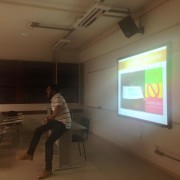To Correct Or Not To Correct? That’s The Question
Have you guys ever seen that little plant that when it’s touched it closes instantly? Well, that’s exactly what happens to our students when teacher end up poorly providing feedback. Correction is the moment in which students really learn and this learning will influence the evaluation they will go through.
For times, teachers believe they have the formula for correction and support the perspective that students must receive feedback firmly for thus order and discipline will be kept. That is not true. Correction is more technical than behavioral and with regard to English classes, order has a different characteristic: it comes from noisy classes because students have to talk and express themselves. Thus, the feedback given by the teacher needs to be delicate, subtle, preferably with as a follow-up activity so that students do not feel they are being punished. A follow-up activity with a good transition will transmit to the students the necessary information for the feedback towards errors without that look of ‘what a boring teacher, he corrects me all the time’ for students not always need to know they are receiving feedback.
According to Ellis, Loewen and Erlam (2006), it is through feedback that acquisition takes place for they have almost all their attention directed to the teacher besides the activity have happened moments before, i.e. it is easy for students to relate the correction to what they said. Among the types of feedback available there are explicit and implicit feedback. As redundant as it may sound, the explicit one is evident for our students that they are being corrected whereas the explicit is not (duh, huh?). The explicit form of feedback is apparent for students there was an error or mistake for correction is directly addressed to the student.
Student: Yesterday I go to the mall.
Teacher: You need past tense here.
Student: Yesterday I went to the mall.
In classrooms with younger students or with a beginner level of proficiency, this type of feedback tends to be more effective for students are said what they should have uttered.
For students with a proficiency level a bit higher (let’s be clear here that i’m not talking about C1s or C2s only), corrections can be made subtly and yet be very effective. Recasts are also a very subtle way of correcting our students without their noticing they are actually being corrected for recasts are part of implicit feedback category.
Student: She will going to the concert tonight.
Teacher: Oh! She will go to the concert. What concert will she go to?
Student: She will go to Foo Fighter’s concert.
Obviously, by using recasts the expectation is that the student notices the proper model of the language and reproduces it from that moment on, although that doesn’t always happen.
Whether we use explicit or implicit feedback, we have to be sure corrections will be made subtly, delicately so we do not block English in our students minds. Furthermore, poorly offered feedback will not generate the desired outcome which means that moment when students say ‘oh yeah, I got it’ will not happen. there isn’t a magic formula for feedback, it hinges on the profile of our students after a thorough scanning by the teachers and on the development of follow-up activities so that our plant do not close.












Deixe uma resposta
Want to join the discussion?Feel free to contribute!